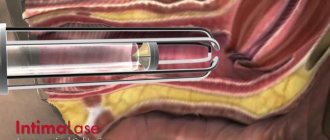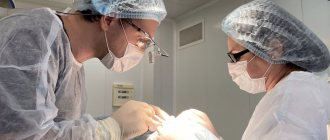A persistent erection is the primary criterion for high male self-esteem. No amount of social success can compensate for a passive penis and the inability to sexually satisfy a partner. Erectile dysfunction can be diagnosed not only in older men. In the age group of 25-40 years, there are also people suffering from this intimate problem. Advertising periodically throws up names of products that “100% relieve erectile dysfunction in men.” However, the opinion of specialist urologists and andrologists on this matter differs significantly from marketing slogans.
The effectiveness of modern methods of surgical treatment
The main reason for the lack of complete blood supply to the cavernous bodies of the penis is excessive venous outflow. That is, the artery fills the organ, but the veins do not hold it. Treatment of vascular erectile dysfunction may require changes in the vascular beds. In this case, doctors surgically stop the discharge of blood by ligating (tying off) the deep dorsal vein.
Practice shows that even such a radical intervention in the long term has a weakening of erectile function.
The human body compensates for a blocked vascular channel by forming new venous channels. After just 2 years, the result will decrease by 30%.
As for trauma to nerve endings, the reconstruction of nerve fibers cannot, in principle, be reproduced. For this reason, what to do about erectile dysfunction? A man will have to rely on independent restoration of innervation, but the process for nerve cells is much slower - the body does not always have enough resources.
If it is not possible to normalize blood flow and blood flow from the penis, then the only way to guarantee a long-term result is penile prosthesis.
Indications for surgical treatment of erectile dysfunction
Psychogenic erectile dysfunction is corrected with the help of a sex therapist. If the arteries and veins are not in order, or fibrous formations are found inside the cavernous bodies of the penis, these factors become determining for radical measures. Indications for suggesting a patient to implant a penile prosthesis are:
- angiopathy due to diabetes mellitus (for erectile dysfunction in diabetes mellitus, treatment is selected strictly individually);
- consequences of injury to the penis or changes after surgical interventions;
- in case of violation of the corpus cavernosum membrane;
- after operations on the pelvic organs, there is a high probability of developing fibrosis and scarring that prevents normal blood supply;
- if there is a pronounced pathology of the cavernous bodies or vessels of the penis (atherosclerosis of the arteries).
Another reason for the inability to have an erection is a violation of the nervous innervation of the genital organ. In such situations, doctors offer surgical treatment for erectile dysfunction in men.
Types of penile prostheses
Modern clinics offer patients the installation of single-component and three-component penile prostheses.
In the first case, the medical product is represented by two cylinders made of a biocompatible material with a titanium core (or spiral) placed inside. Three-component models, in addition to cylinders (without an internal rod), are complemented by a pump and a reservoir with saline solution.
The advantages of a one-component penile prosthesis include cost. They are relatively inexpensive, with a sufficient margin of safety. They may be recommended to treat erectile dysfunction in older men when there are budget constraints. In this case, the penis will be constantly in a tense state, which is not always convenient in aesthetic and everyday terms.
The use of three-component implants for erectile dysfunction, according to reviews from doctors and patients, makes it possible to almost completely compensate for the function of the corpora cavernosa of the penis and restore the possibility of full sexual intercourse. A man can initiate an erection without attracting his partner's attention to his features. Erectile dysfunction in men after 50 can have many causes, but at this age not everyone is ready to retire and give up sex.
Comparison table of two types of penile prostheses
| Criterion | One-component penile prosthesis | Three-component penile prosthesis |
| Imitation of natural erection | The penis remains in an erect state constantly. | The penis can be either “excited” or at rest. |
| Mechanism | Giving the “working” position and lowering is done manually. The penis is held in place by an internal spiral core that can be bent or unbent. | To create an erection effect, saline solution is pumped into the implant cylinders using a pump. The intensity can be adjusted by the number of presses. To make the penis fall off, just press the valve responsible for the pressure. |
| Impact on living tissue | The tissues of the penis are under constant stress. | By regulating the pressure within the system, the organ tissues can “rest”. |
| Price | Relatively democratic | More than 2 times more expensive than single-component ones. |
| Difficulty of installation | Requires placement inside the corpora cavernosa of the penis. | In addition to placing the cylinders, you need to install a reservoir with saline solution behind the pubic bone, connect the system with tubes, and place the pump inside the scrotum. |
Penile prosthetics (penile prosthetics)
There are 2 main types of penile prosthesis
c: inflatable and semi-rigid.
Inflatable implants (2-component and 3-component)
Three-component prostheses are the most advanced, effective and easy-to-use model of prosthesis, since thanks to the special structure of the device you can independently control your erection for the required amount of time.
Three-component implants include:
- a special fluid-filled reservoir that is placed under the abdominal wall
- two inflatable cylinders placed in the shaft of the penis
- pump with valve placed in the scrotum
To achieve an erection, pressing a valve in the scrotum forces fluid from a reservoir into the cylinders. After achieving the required erection and having sexual intercourse, you will need to drain the liquid back into the reservoir by pressing the valve again.
The two-piece model works in a similar way, but the fluid reservoir is part of a pump implanted in the scrotum.
Semi-rigid prostheses (rods)
Semi-rigid devices are always solid. Thus, the penis is always in a semi-active state. That is, to perform sexual intercourse, it is enough to simply raise the penis.
Each of the above methods has its own advantages and disadvantages. A full examination and conversation with your doctor and surgeon will help you determine the most optimal method of treating erectile dysfunction for you.
Comparison of different types of prostheses
| Prosthesis | Advantages | Flaws |
| Three-component | The most natural erection Natural position of the penis when deflating the pump | Consists of more parts, malfunctions are possible Requires placement of a reservoir in the abdominal cavity |
| Two-component | Natural position of the penis when deflating the pump | Mechanically more complex than its semi-rigid counterpart Less firm erection than its three-part counterpart |
| Semi-rigid | Reliability Ease of use | The penis is always in a semi-hard state Constant pressure on the structures of the penis - the risk of complications is higher Inconvenient to hide under clothes |
The installation of prostheses is carried out percutaneously, that is, using a small 1.5-centimeter incision on the penis near the scrotum, which is then practically invisible. Restoration of activity (including sexual activity) is possible 4-6 weeks after surgery. More precise dates should be discussed with your doctor in each specific case.
If you have any additional questions about this operation, you can contact us online or by phone indicated in the profile header, and also schedule a consultation with one of our specialists.
By choosing us, you choose experienced specialists, high-quality examination and surgical treatment according to international standards.
Before hospitalization, you can meet the staff of our department, who specialize in the surgical treatment of erectile dysfunction.
Features of penile prosthesis surgery and the postoperative period
Before the operation, in any case, a diagnosis of erectile dysfunction is prescribed. Before the operation, in addition to the hospital surgical complex of tests, Dopplerography of the vessels of the penis is performed. The patient is admitted to the hospital one day before surgery.
During the operation, spinal anesthesia is used. The implants are installed through a small incision at the base of the penis. Subsequently, the tissue is sutured with a cosmetic suture, which makes the scar almost invisible after complete healing. The doctor will definitely check the system for functionality before completing the installation. The saline solution is pre-pumped into the system. The implants are prepared before the operation by an employee of the manufacturer.
- A one-component penile prosthesis
is represented by paired semi-rigid cylinders that ensure the retention of the penis in the desired condition. Installation is carried out inside the cavernous bodies. - A three-component prosthesis
involves, in addition to installing cylinders, placing a reservoir with saline solution up to 100 ml behind the pubic bone. the pump is placed in the scrotum last, after successful testing of the connected system.
The patient stays in the hospital for 2 days, after 10 days the stitches are removed. The unpleasant sensations disappear on the third day. In this case, the full launch of the prosthesis will be carried out in 3 weeks, and sexual activity can begin no earlier than after 2 months. A man can start working as early as day 5, but the doctor will impose restrictions on physical activity.
Recovery of a man after penile prosthesis.
Life after penile prosthesis. The first days after surgery will be the most difficult. It is for this reason that it was decided to publish an article devoted to the issue of rehabilitation of men who underwent penile prosthesis. In which I will describe in detail the general condition, complaints and sensations that most men experience in the first three days after penile prosthesis.
- FIRST DAYS after penile prosthesis. The day after surgery, the patient may feel discomfort in the perineum, scrotum and shaft of the penis. The discomfort may increase and become painful when sitting (especially on soft surfaces) or when walking.
- In order to prevent postoperative bleeding, upon completion of implantation of a three-component hydraulic implant (Coloplas or AMS), the implant is activated until the next morning.
- The first dressing after penile prosthesis involves changing the dressing and deactivating the implant (the doctor will reduce the pressure in the implant cylinders). The process may be accompanied by unpleasant and painful sensations.
- After the implant is deactivated, the doctor will remove the drainage from the scrotum. Drainage is a device that allows you to clean the surgical area from wound discharge and blood, and prevents the formation of hematomas. The removal process is almost painless.
- It is important to understand that on the first post-operative morning, any pressure on the pump (located in the scrotum) and on the cylinders of the penis (located in the shaft of the penis) will be painful or extremely unpleasant, which is normal.
- SECOND DAY after penile prosthesis. The second dressing is less painful, since no manipulation of the implant occurred. It involves treating the surgical area with an antiseptic solution and changing a sterile dressing.
- It is important to understand that on the first post-operative morning, any pressure on the pump (located in the scrotum) and on the cylinders of the penis (located in the shaft of the penis) will be painful or extremely unpleasant, which is normal.
- THIRD DAY after penile prosthesis. Pain and discomfort noticeably subside even in a sitting position and when lifting. With each subsequent day, pain symptoms will noticeably decrease until they disappear completely. Postoperative sutures will be removed on days 10-12.
- At the time of discharge, the doctor must instruct the patient in detail about how and when to activate and deactivate the implant. How and by how much to increase the duration of activation, what you need to pay attention to when resuming sexual activity.
Sexual life after penile prosthesis. Following all the specialist’s recommendations, it is possible to begin sexual activity within 1.5 months after surgical treatment. It is this nature of time that is required to restore the integrity and healing of the inner membranes of the penis. Penile prosthesis does not affect urination, orgasm, ejaculation and reproductive function of a man!
ALL ABOUT PENAL PROSTHETICS
PHOTOS OF ALL STAGES OF THE PENTAL PROSTHETICS OPERATION
APPEARANCE OF THE PENIS AFTER PENAL PROSTHETICS








